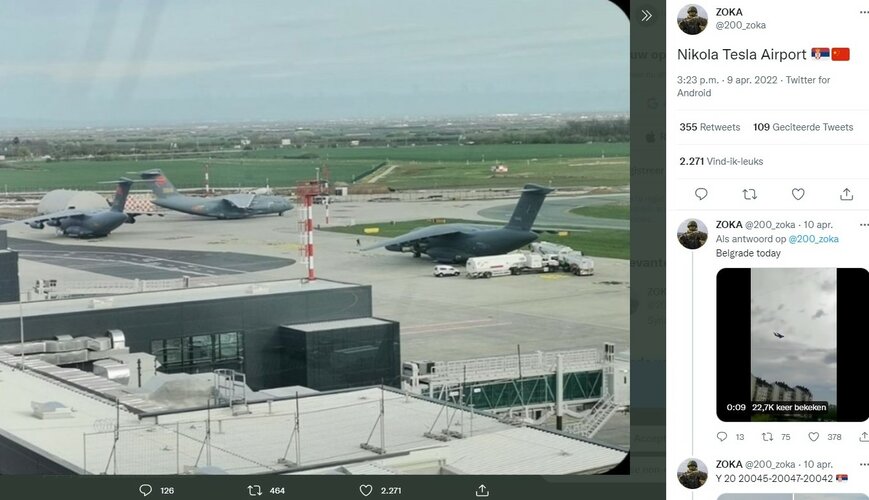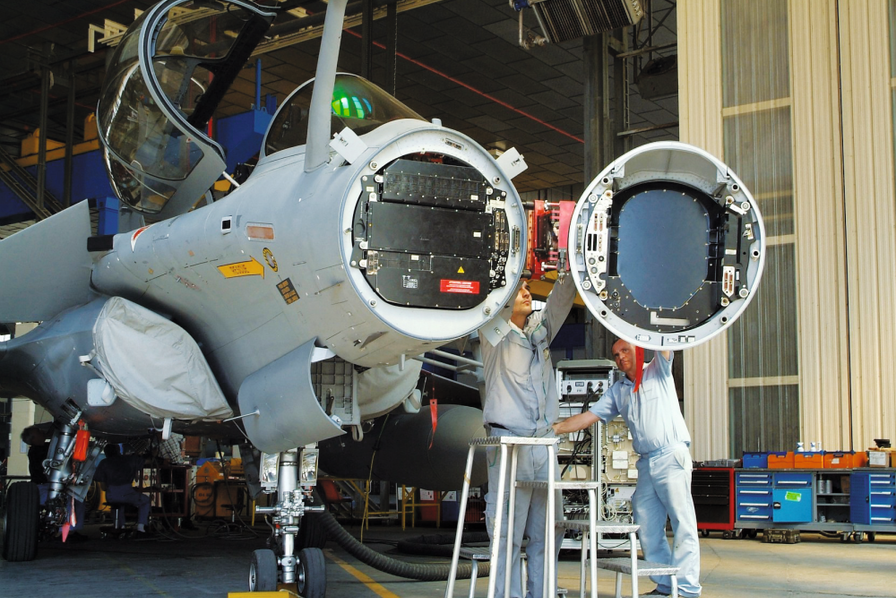You are using an out of date browser. It may not display this or other websites correctly.
You should upgrade or use an alternative browser.
You should upgrade or use an alternative browser.
Dassault Rafale NEWS ONLY
- Thread starter Triton
- Start date
Deltafan
ACCESS: Top Secret
- Joined
- 8 May 2006
- Messages
- 1,697
- Reaction score
- 2,317
For its part, the Iraqi Air Force is seeking French Rafale fighter jets. In September 2021, the chairman of the Security and Defense Committee of Iraq’s parliament, Mohammed Redha al-Haidar, revealed Iraq and Paris signed a contract for the aircraft.
“The Iraqi Air Force is intending to purchase 14 French Rafale fighter jets at a cost of $240 million, which will be paid in oil rather than cash,” Ricklefs told Defense News about the deal.

Iraq seeks French drones and jets, additional Russian tanks
Iraq’s military is seeking several defense systems of different origins, including French Rafale fighter jets, drones and artillery, as well as Russian T-90 tanks, with some ongoing negotiations reaching an advanced stage.
As usual: to be confirmed...
- Joined
- 11 February 2010
- Messages
- 1,650
- Reaction score
- 2,702
That's quite a while. Tho it shows that weapons procurement takes time. and sometime a very long time.
 www.janes.com
www.janes.com
Indonesia to receive six Rafales by 2026
The Indonesian Air Force (Tentara Nasional Indonesia Angkatan Udara: TNI-AU) will receive the first batch of six Dassault Rafale multirole combat aircraft by 2026.
For its part, the Iraqi Air Force is seeking French Rafale fighter jets. In September 2021, the chairman of the Security and Defense Committee of Iraq’s parliament, Mohammed Redha al-Haidar, revealed Iraq and Paris signed a contract for the aircraft.
“The Iraqi Air Force is intending to purchase 14 French Rafale fighter jets at a cost of $240 million, which will be paid in oil rather than cash,” Ricklefs told Defense News about the deal.
Iraq seeks French drones and jets, additional Russian tanks
Iraq’s military is seeking several defense systems of different origins, including French Rafale fighter jets, drones and artillery, as well as Russian T-90 tanks, with some ongoing negotiations reaching an advanced stage.www.defensenews.com
As usual: to be confirmed...
Heirs to the Mirage F1EQ, it seems...
Are you sure it's 272? I'm getting 284 Rafales exported.interesting so 42!
that means life time exports
Rafale - 272
Mirage 2000 - 277
(these both include the export of used French aircraft as well).
Rafale is on track to export more aircraft than its predecessor
Egypt 24+30
Qatar 24+12
India 36
Croatia 12
Greece 24
UAE 80
Indonesia 42
Though, I'm also getting more M2000 exported than 277 as well, if the French M2000 wiki page is to be believed.
Are you sure it's 272? I'm getting 284 Rafales exported.interesting so 42!
that means life time exports
Rafale - 272
Mirage 2000 - 277
(these both include the export of used French aircraft as well).
Rafale is on track to export more aircraft than its predecessor
Egypt 24+30
Qatar 24+12
India 36
Croatia 12
Greece 24
UAE 80
Indonesia 42
Though, I'm also getting more M2000 exported than 277 as well, if the French M2000 wiki page is to be believed.
From memory, 620 Mirage 2000s were built and the French AF got 315, that would left 305 exported...
As for the F1: 700+ built, 246 went to the French.
http://www.airvectors.net/avmirf1.html#m3
Going with the 246 French machines plus C. G website detailed export orders, I get 680 aircraft of which 434 were exported.
There is some uncertainity over the Iraqis - 93 to 106 aircraft.
There were four prototypes (01 that killed René Bigand plus the 02 - 03 - 04)
That would be 684... plus the F1-M53: 685.
One thing is sure: the F1 is still way ahead. And of course the Mirage III extended family, at 1400+
Last edited:
Deltafan
ACCESS: Top Secret
- Joined
- 8 May 2006
- Messages
- 1,697
- Reaction score
- 2,317
Yes, 284 Rafale export: 260 new + 24 used (12/12 for Croatia and 12/24 for Greece)Are you sure it's 272? I'm getting 284 Rafales exported.interesting so 42!
that means life time exports
Rafale - 272
Mirage 2000 - 277
(these both include the export of used French aircraft as well).
Rafale is on track to export more aircraft than its predecessor
Egypt 24+30
Qatar 24+12
India 36
Croatia 12
Greece 24
UAE 80
Indonesia 42
Though, I'm also getting more M2000 exported than 277 as well, if the French M2000 wiki page is to be believed.
Last edited:
- Joined
- 29 November 2010
- Messages
- 1,774
- Reaction score
- 3,477
I used the numbers from English Wikipedia, this includes situations like Greece where they are receiving some used airframesAre you sure it's 272? I'm getting 284 Rafales exported.interesting so 42!
that means life time exports
Rafale - 272
Mirage 2000 - 277
(these both include the export of used French aircraft as well).
Rafale is on track to export more aircraft than its predecessor
Egypt 24+30
Qatar 24+12
India 36
Croatia 12
Greece 24
UAE 80
Indonesia 42
Though, I'm also getting more M2000 exported than 277 as well, if the French M2000 wiki page is to be believed.
same for the Mirage 2000, counting Brazil's ex M2Ks even though they are used.
I think the issue may have been either with Qatars 12 additional orders or Croatia's 12 orders that were not updated on the page when I wrote that.
Strikes somewhat threaten to burden an already disctutable slow production rate for the Rafale (emphasising is not mine but the one from the source editor [!] ) :
Notice that, logically, availability rate in frontline squadrons should drop invariably as a consequence, sooner or later, since the executive's comment above suggests IMOHO that components defaulting on the production line are sourced directly from stocks to maintain a relevant output of completed airframe.
En conséquence, plus aucun fuselage de Rafale n’aurait quitté le site de Biarritz depuis fin 2021. À Argenteuil, la cadence serait tombée de deux fuselages produits chaque mois à un tous les trois mois, dont le dernier fin novembre 2021. Ce que ne confirme pas Dassault Aviation. « Le mouvement et ses conséquences sont très variables d’un site à l’autre. Les mouvements ralentissent le travail et nous avons des tentatives de blocage, indique un porte-parole de l’entreprise. Nous agissons pour réduire les retards. Pour l’instant nous parvenons à livrer les éléments entre établissements et les avions aux clients. » Le site de Mérignac, qui assure l’assemblage final des avions, maintient un rythme de production normal jusqu’à présent.
--------------************-----------------
As a result, no more Rafale fuselages have left the Biarritz site since the end of 2021. In Argenteuil, the rate have fallen from two fuselages each month to one every three months, the last of which at the end of November 2021. This couldn't be confirmed by Dassault Aviation. “The movement and its consequences are very variable from one site to another. The movements slow down the work and we have blocking attempts, indicates a spokesman of the company. We are taking action to reduce delays. At the moment we are managing to deliver each sub-asswmbly b/w sites and aircraft to customers. The Mérignac site, which handles the final assembly of the aircraft, has followed a normal production rate so far.
Notice that, logically, availability rate in frontline squadrons should drop invariably as a consequence, sooner or later, since the executive's comment above suggests IMOHO that components defaulting on the production line are sourced directly from stocks to maintain a relevant output of completed airframe.
Last edited:
Depends on whether Rafale spares are made by Dassault or by other component manufacturers.logically, availability rate in frontline squadrons should drop invariably as a consequence
As I understand it the latter is more likely, ie. most spares will come from Snecma (engines), Thales (electronics), Messier Bugatti (landing gear, tires & brakes) and other specialized manufacturers etc. Dassault’s in-house work is mostly limited to airframe structures… not sure how often those structures would have to be switched out.
So very unlikely IMHO.
Last edited:
Thales to up cadences and increases production capacity related to the Rafale:
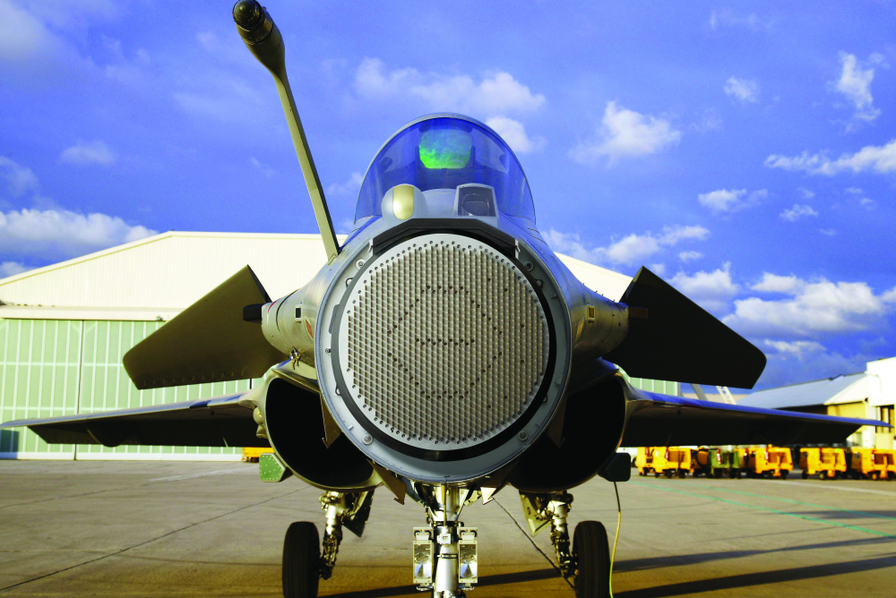
 www.usinenouvelle.com
www.usinenouvelle.com
Aujourd’hui, la multiplication des contrats à l’export change complètement la donne. Pour répondre à la demande, Thales envisage de produire jusqu’à une cadence de 4,5 équipements par mois, contre 2,5 actuellement. Si le groupe reconnaît qu’il s’agit d’un bond dans l’inconnu en termes d’industrialisation, il ne laisse rien au hasard.
La montée en puissance se fera progressivement pour adapter l’outil industriel et réaliser les embauches nécessaires. Il faut ainsi un an par exemple pour passer d’une cadence de 2,5 éléments produits par mois à 3,5 par mois et autant pour franchir le palier suivant. Thales prévoit donc d’atteindre la cadence 4,5 à l’horizon 2025.
********////*********
Today, the proliferation of export contracts completely changes the situation. To meet demand, Thales plans to produce up to 4.5 pieces of equipment per month, compared to 2.5 currently. If the group recognizes that it is a link in the unknown in terms of industrialization, it leaves nothing to chance.
The ramp-up will be done gradually to adapt the industrial tool and make the necessary hires. An example is therefore needed to move from a rate of 2.5 items produced per month to 3.5 per month and as much to overcome the next level. Thales therefore plans to reach the 4.5 rate by 2025.

Embauches, investissements industriels... Comment Thales s’organise pour répondre aux ventes record du Rafale à l’export
Le groupe d’électronique et de défense Thales vise des cadences de production d’équipements pour le Rafale jamais atteintes d’ici...-Aéro - Spatial
- Joined
- 29 November 2010
- Messages
- 1,774
- Reaction score
- 3,477

With 3 More Rafale Jets, India Receives Entire Consignment Of 36 Planes From France
With the delivery of three more Rafale fighter jets on Wednesday, France completed the entire consignment of 36 Rafale fighter planes to the country. India had signed an inter-governmental agreement w
 bharatshakti.in
bharatshakti.in
on a related note, are there any countries that operate (or will operate) both F-35s and Rafales?
the only one I can think of is, potentially Greece.
Just a nice pic (source: the NYtimes.com) :

More on this picture here, where it is said that the mission involved 4 refueling and was launched from France (Mont de Marsan) with a flight back (seems the duo of Rafale is providing escort to the MRTT from where this shot was taken):
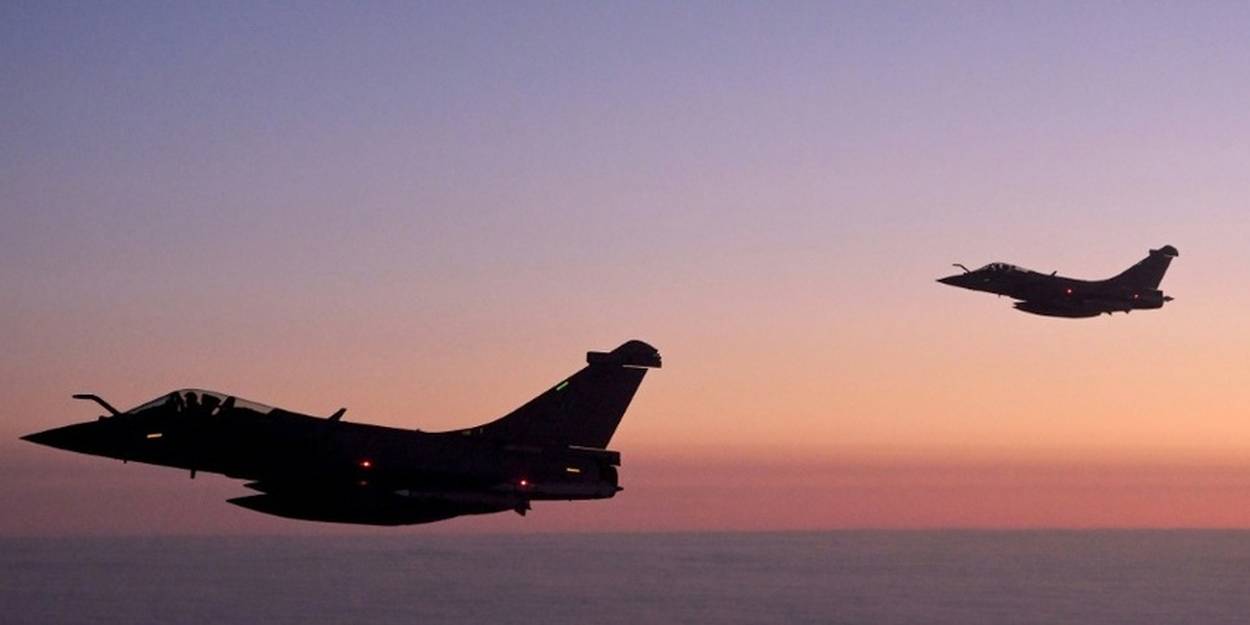
 amp.lepoint.fr
amp.lepoint.fr
(edited)
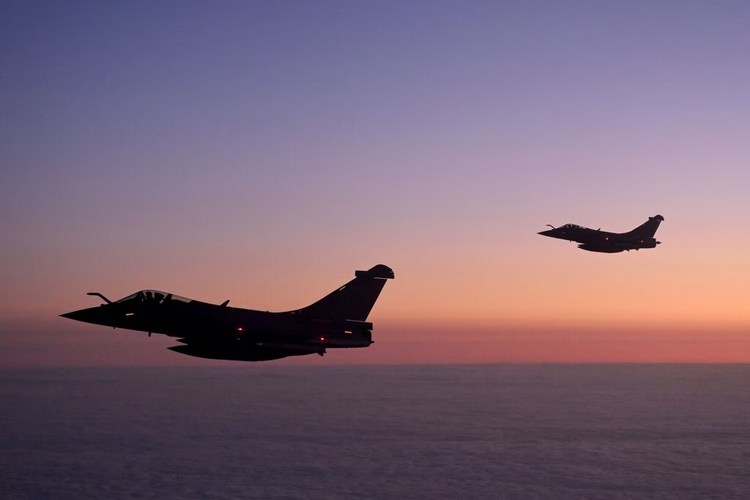
French fighter jets patrolling the airspace over Poland as part of NATO operations on Friday.Credit...Nicolas Tucat/Agence France-Presse — Getty Images
More on this picture here, where it is said that the mission involved 4 refueling and was launched from France (Mont de Marsan) with a flight back (seems the duo of Rafale is providing escort to the MRTT from where this shot was taken):

Au-dessus de la Pologne, la "police du ciel" des avions Rafale français
Au-dessus des nuages du ciel polonais, une tige métallique sort d'un Airbus de l'armée française. Un avion Rafale s'y colle pour se ravitailler et...
(edited)
Last edited:
Mont de Marsan - no "t" please (been born there and then my parent moved a safe distance away).Mont de Marsant
(Nitpicking mode OFF)
isayyo2
Lurker alert
- Joined
- 24 November 2011
- Messages
- 1,131
- Reaction score
- 2,330
Pass the White Burgundy pleaseThe culprit will obligingly serve himself a double portion of Foie Gras and a second glass of heavy red wine to make good figure for the regional offense.
San(s)T(é) ...
Deltafan
ACCESS: Top Secret
- Joined
- 8 May 2006
- Messages
- 1,697
- Reaction score
- 2,317
According to concordant sources, Egypt is interested in conventionally powered Barracuda submarines, which would be manufactured by Naval Group.
(...)
The country led by Marshal Abdel Fattah al-Sissi is also studying the purchase of a second-hand aircraft carrier, which would be armed with around twenty Rafale Marine.
(...)

Naval Group : des sous-marins et un porte-avions pour l'Egypte ?
Le Caire a exprimé un intérêt auprès de Paris et de Naval Group pour acquérir des sous-marins Barracuda à propulsion conventionnelle ainsi qu'un porte-avions doté de Rafale marine.
As usual: to be confirmed...
- Joined
- 29 September 2006
- Messages
- 1,793
- Reaction score
- 1,360
Purchase of a secondhand aircraft carrier, capable of using Rafales? That could only be São Paulo, but there’d be a hell of a lot of work to get her operational.According to concordant sources, Egypt is interested in conventionally powered Barracuda submarines, which would be manufactured by Naval Group.
(...)
The country led by Marshal Abdel Fattah al-Sissi is also studying the purchase of a second-hand aircraft carrier, which would be armed with around twenty Rafale Marine.
(...)

Naval Group : des sous-marins et un porte-avions pour l'Egypte ?
Le Caire a exprimé un intérêt auprès de Paris et de Naval Group pour acquérir des sous-marins Barracuda à propulsion conventionnelle ainsi qu'un porte-avions doté de Rafale marine.www.latribune.fr
As usual: to be confirmed...
isayyo2
Lurker alert
- Joined
- 24 November 2011
- Messages
- 1,131
- Reaction score
- 2,330
Russia needs some fast cash and it’s willing to swap their Su-35 deal for the Kuznetsov?Purchase of a secondhand aircraft carrier, capable of using Rafales? That could only be São Paulo, but there’d be a hell of a lot of work to get her operational.According to concordant sources, Egypt is interested in conventionally powered Barracuda submarines, which would be manufactured by Naval Group.
(...)
The country led by Marshal Abdel Fattah al-Sissi is also studying the purchase of a second-hand aircraft carrier, which would be armed with around twenty Rafale Marine.
(...)

Naval Group : des sous-marins et un porte-avions pour l'Egypte ?
Le Caire a exprimé un intérêt auprès de Paris et de Naval Group pour acquérir des sous-marins Barracuda à propulsion conventionnelle ainsi qu'un porte-avions doté de Rafale marine.www.latribune.fr
As usual: to be confirmed...
- Joined
- 29 November 2010
- Messages
- 1,774
- Reaction score
- 3,477
lol i know its a joke... butRussia needs some fast cash and it’s willing to swap their Su-35 deal for the Kuznetsov?Purchase of a secondhand aircraft carrier, capable of using Rafales? That could only be São Paulo, but there’d be a hell of a lot of work to get her operational.According to concordant sources, Egypt is interested in conventionally powered Barracuda submarines, which would be manufactured by Naval Group.
(...)
The country led by Marshal Abdel Fattah al-Sissi is also studying the purchase of a second-hand aircraft carrier, which would be armed with around twenty Rafale Marine.
(...)

Naval Group : des sous-marins et un porte-avions pour l'Egypte ?
Le Caire a exprimé un intérêt auprès de Paris et de Naval Group pour acquérir des sous-marins Barracuda à propulsion conventionnelle ainsi qu'un porte-avions doté de Rafale marine.www.latribune.fr
As usual: to be confirmed...
say Russia ends up selling the Kuznetsov.. wouldn't they need to add cats to it? not sure if the US will be willing to allow it to be placed on a Russian ship..
but then again, Rafale supposedly took off from a ski jump in India recently, with decent loads.
- Joined
- 11 February 2010
- Messages
- 1,650
- Reaction score
- 2,702
Or French selling CDG. That's even better deal for India TBH.
- Joined
- 29 November 2010
- Messages
- 1,774
- Reaction score
- 3,477
imagine if France went with the PA2.. they may have gotten their first one around nowOr French selling CDG. That's even better deal for India TBH.
then they could sell the CDG to India or Egypt, as well as more Rafales!
- Joined
- 3 September 2006
- Messages
- 1,475
- Reaction score
- 1,470
IMO the initial question remains: Why on Earth would the Egyptian navy need an aircraft carrier?
To brag bigger and longer than the neighbours ?
AFAIK it's not like they have overseas possessions to defend, and their only sorta-colonial-claim is Sudan, for which a carrier is not not really useful.
Even to go brag off Libya, a carrier won't be useful enough to justify its cost.
(without even discussing how many assets would be tied up by the protection of such a high-viz target)
To brag bigger and longer than the neighbours ?
AFAIK it's not like they have overseas possessions to defend, and their only sorta-colonial-claim is Sudan, for which a carrier is not not really useful.
Even to go brag off Libya, a carrier won't be useful enough to justify its cost.
(without even discussing how many assets would be tied up by the protection of such a high-viz target)
- Joined
- 6 September 2006
- Messages
- 4,833
- Reaction score
- 9,452
Glad someone asked the killer question - why?
Makes no sense to me, especially if it is the São Paulo (surely the Indian's aren't thinking of selling Gorshkov are they?).
Presumably Turkey would be seen as the neighbour with bragging rights to beat, having now started building LHAs and one day perhaps getting F-35Bs aboard them (never say never).
Makes no sense to me, especially if it is the São Paulo (surely the Indian's aren't thinking of selling Gorshkov are they?).
Presumably Turkey would be seen as the neighbour with bragging rights to beat, having now started building LHAs and one day perhaps getting F-35Bs aboard them (never say never).
Could Rafale go STOBAR out of a modified Mistral hull, with a ski-jump ?
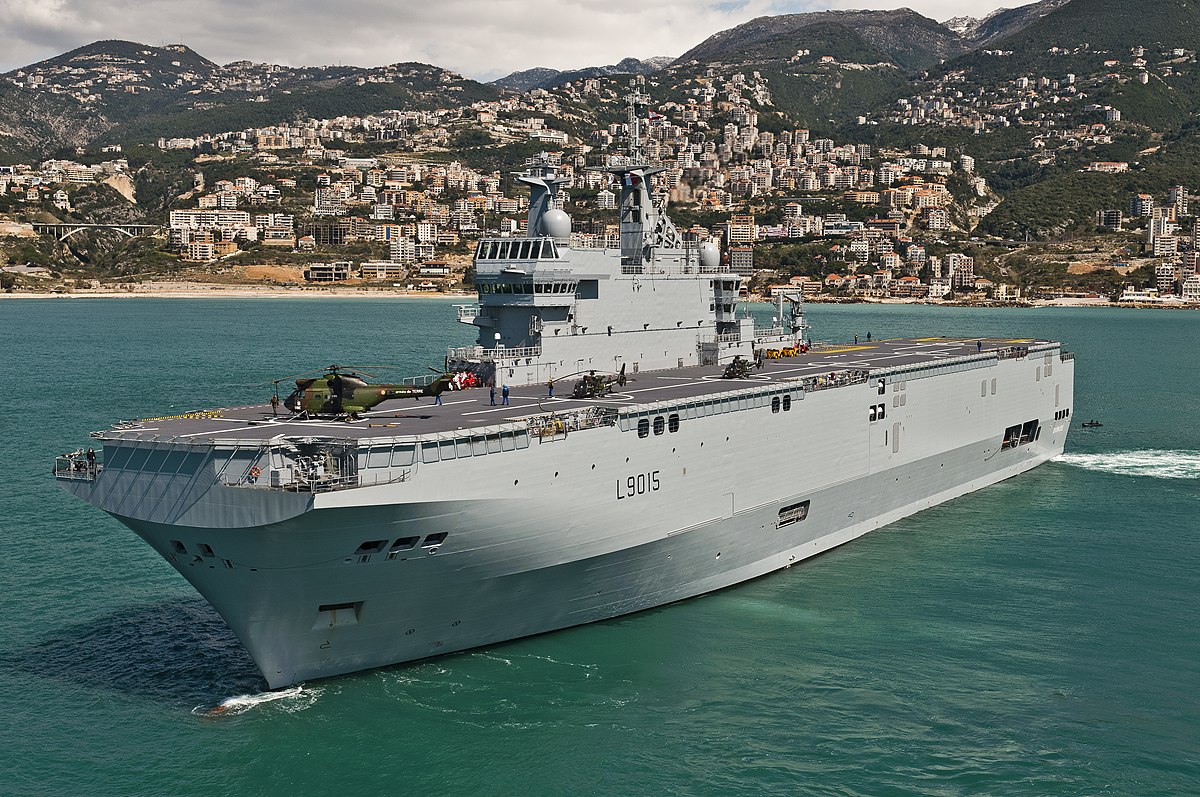
 en.wikipedia.org
en.wikipedia.org
Hmmm, 199 m sounds a bit short... Cavour, Juan Carlos, Trieste are much longer, in a 240 m ballpark... and F-35B is VSTOL.

Mistral-class landing helicopter dock - Wikipedia
Hmmm, 199 m sounds a bit short... Cavour, Juan Carlos, Trieste are much longer, in a 240 m ballpark... and F-35B is VSTOL.
- Joined
- 29 November 2010
- Messages
- 1,774
- Reaction score
- 3,477
isn't Egypt involved in some kind of cold war with Turkey? they are on opposite sides in Libya, as well as having massive problems with the new EEZ claims in the East Med. With Egypt-Greece on one side (with a friendly Russia), and Turkey on the other.
but I still don't see it justifying a carrier.
but I still don't see it justifying a carrier.
I wonder if a Mistral hull could be stretched to 240 m: comparable to Trieste / Cavour / Juan Carlos. Never realized how... short the Mistrals are.
But not many Rafales would fit inside, even if they could achieve STOBAR from the deck.
That's the other big issue: without a wing fold, they take more hangar room inside the hull...
But not many Rafales would fit inside, even if they could achieve STOBAR from the deck.
That's the other big issue: without a wing fold, they take more hangar room inside the hull...
- Joined
- 29 November 2010
- Messages
- 1,774
- Reaction score
- 3,477
I believe the F-35B and Rafale have the same wingspan of 11m right? (correct me if wrong)I wonder if a Mistral hull could be stretched to 240 m: comparable to Trieste / Cavour / Juan Carlos. Never realized how... short the Mistrals are.
But not many Rafales would fit inside, even if they could achieve STOBAR from the deck.
That's the other big issue: without a wing fold, they take more hangar room inside the hull...
if so..
Cavour could certainly handle 20 fixed wing fighter jets of that size..
but im worried that with out an angled deck.. take offs and landings cant be done simultaneously
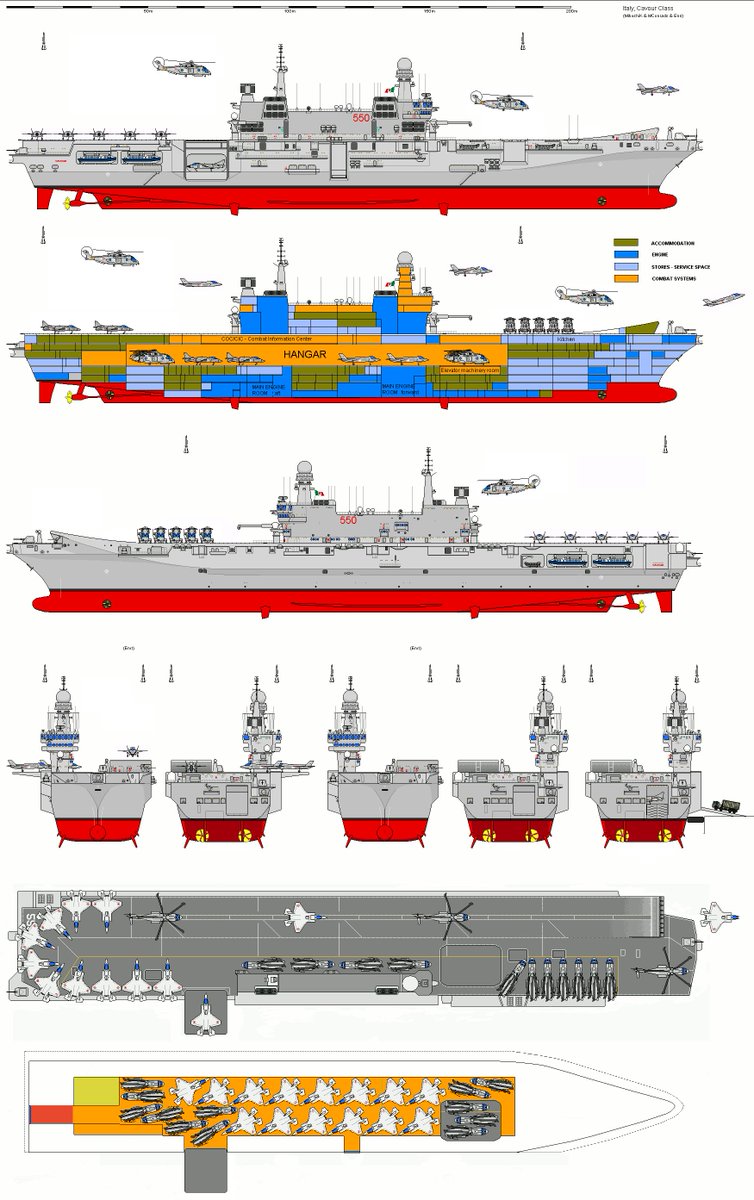
Deltafan
ACCESS: Top Secret
- Joined
- 8 May 2006
- Messages
- 1,697
- Reaction score
- 2,317
The French Barracuda submarines are long-range submarines, unlike the Scorpene (Even if it's range is more than enough for the Mediterranean), also made by France.isn't Egypt involved in some kind of cold war with Turkey? they are on opposite sides in Libya, as well as having massive problems with the new EEZ claims in the East Med. With Egypt-Greece on one side (with a friendly Russia), and Turkey on the other.
but I still don't see it justifying a carrier.
I am not Sissi, and the elements of the article remain to be confirmed. But, if it is, it seems to show the will to acquire a high seas fleet, even if it seems quite strange in the today's Egyptian context.
Now, with the additional costs in all areas (especially in basic necessities, such as food) that will be brought about by the war in Ukraine, perhaps Sissi will have other immediate worries than to buy submarines, aircraft carriers and Rafale Marine (except if the money from the hydrocarbons compensate for the additional costs in question)...
Last edited:
kaiserd
I really should change my personal text
- Joined
- 25 October 2013
- Messages
- 1,657
- Reaction score
- 1,726
My geopolitical reading of this may be wrong but I had thought there was an element of the Gulf States (principally but not solely Saudi Arabia) helping to support and pay for some of Egypt’s more recent extravagant military purchases (the Mistral, etc). Some of this appears political (supporting the current Egyptian regime, a down payment to Russia, France etc re: future political and economic influence, etc.) but also practical/ logically minded (i.e. the Gulf states want this type of capability but know their navies are too small to support it so there’s a degree of outsourcing to Egypt in this regard).
If that type of scenario will actually extend out to all the ambitions set out above is an open question.
If that type of scenario will actually extend out to all the ambitions set out above is an open question.
Last edited:
- Joined
- 29 November 2010
- Messages
- 1,774
- Reaction score
- 3,477
what ever happened to Rafale with CFTs?
I remember in the early days, they did quite a few flight tests with CFTs attached.
was there no interest by any operators?
I remember in the early days, they did quite a few flight tests with CFTs attached.
was there no interest by any operators?
Seemingly not...or perhaps some have them but in storage?I remember in the early days, they did quite a few flight tests with CFTs attached.
was there no interest by any operators?
- Joined
- 9 October 2009
- Messages
- 21,969
- Reaction score
- 13,616
The CFTs were among the many causalities of budgetary cutbacks I believe.
Next Thursday should see Greece signing for the 6 extra Rafale (and fregates) :

 www.latribune.fr
www.latribune.fr
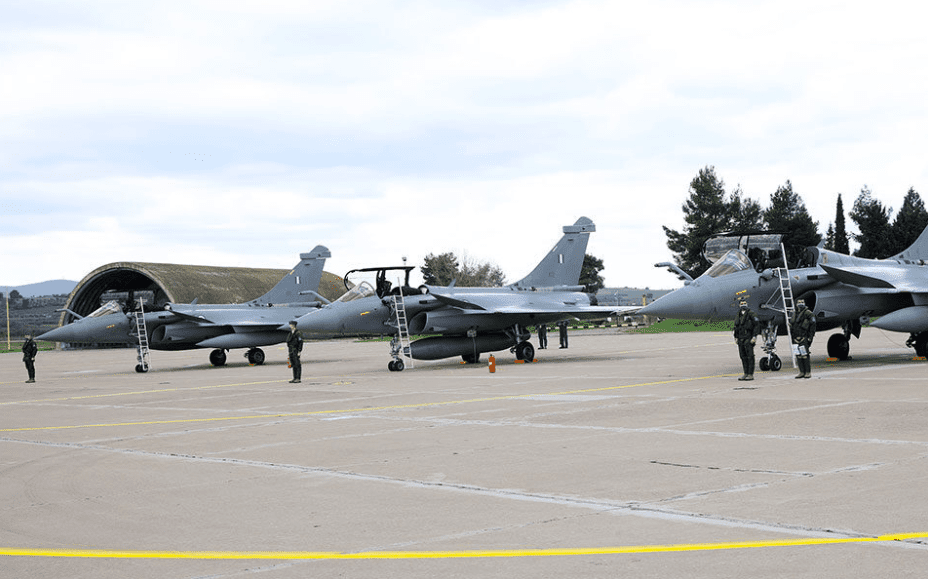
 greekcitytimes.com
greekcitytimes.com

Rafale, frégates FDI : Dassault et Naval Group attendus jeudi en Grèce pour signer les contrats
Les PDG de Dassault Aviation et de Naval Group, Eric Trappier et Pierre Eric Pommellet, seront en Grèce pour signer deux contrats d'une valeur de 4 milliards d'euros. Respectivement six Rafale et trois frégates FDI. Florence Parly devrait participer à la cérémonie de signature

EXCLUSIVE VIDEO: Greece's New Rafale Jets To Participate In Celebratory Flyover
On Friday, fighter jets of the Hellenic Air Force (including two Rafales, one Mirage 2000, two F-16s, and F-4) conducted exercises over Attica at approximately 10 a.m.
- Joined
- 29 November 2010
- Messages
- 1,774
- Reaction score
- 3,477
Novi Avion finally arrives.. but this time as a larger twin-engined aircraft..
made entirely in France.
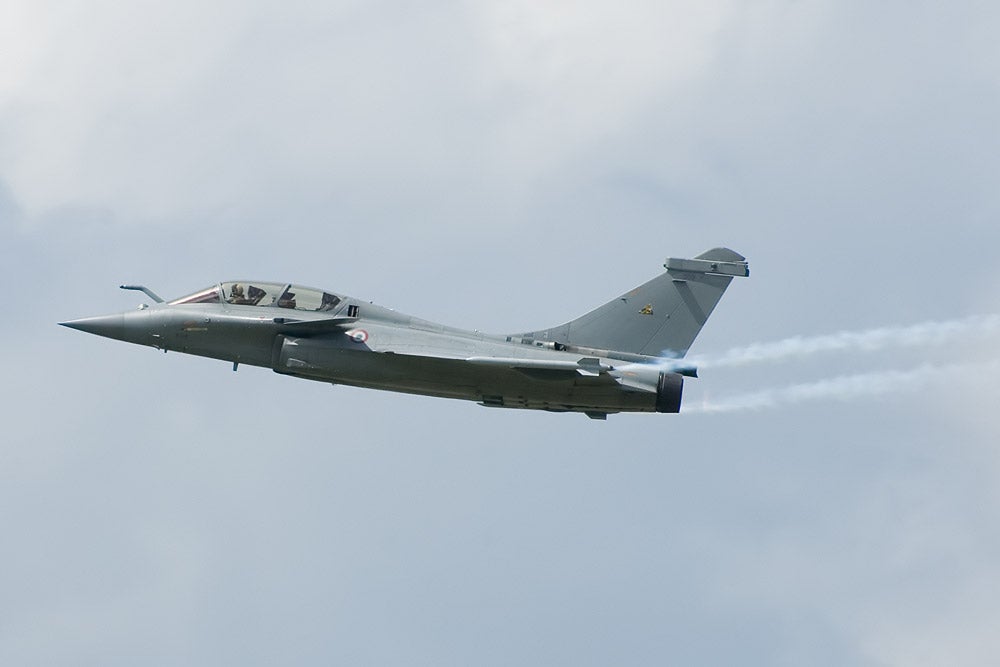
 www.airforce-technology.com
www.airforce-technology.com
made entirely in France.

Serbia in talks to buy 12 new Rafale jets
Serbian President Aleksandar Vucic has said that the country is holding talks to purchase at least 12 Rafale multipurpose fighter jets.
Dreamfighter
'Senior Something'
- Joined
- 13 July 2008
- Messages
- 483
- Reaction score
- 646
Novi Avion finally arrives.. but this time as a larger twin-engined aircraft..
made entirely in France.

Serbia in talks to buy 12 new Rafale jets
Serbian President Aleksandar Vucic has said that the country is holding talks to purchase at least 12 Rafale multipurpose fighter jets.www.airforce-technology.com
Which will then be shipped by Y-20 transports from Belgrade to ...
Attachments
Similar threads
-
-
France-Germany-Spain Future Combat Air System (FCAS / SCAF / FSAC)
- Started by Deltafan
- Replies: 1K
-
-
-

